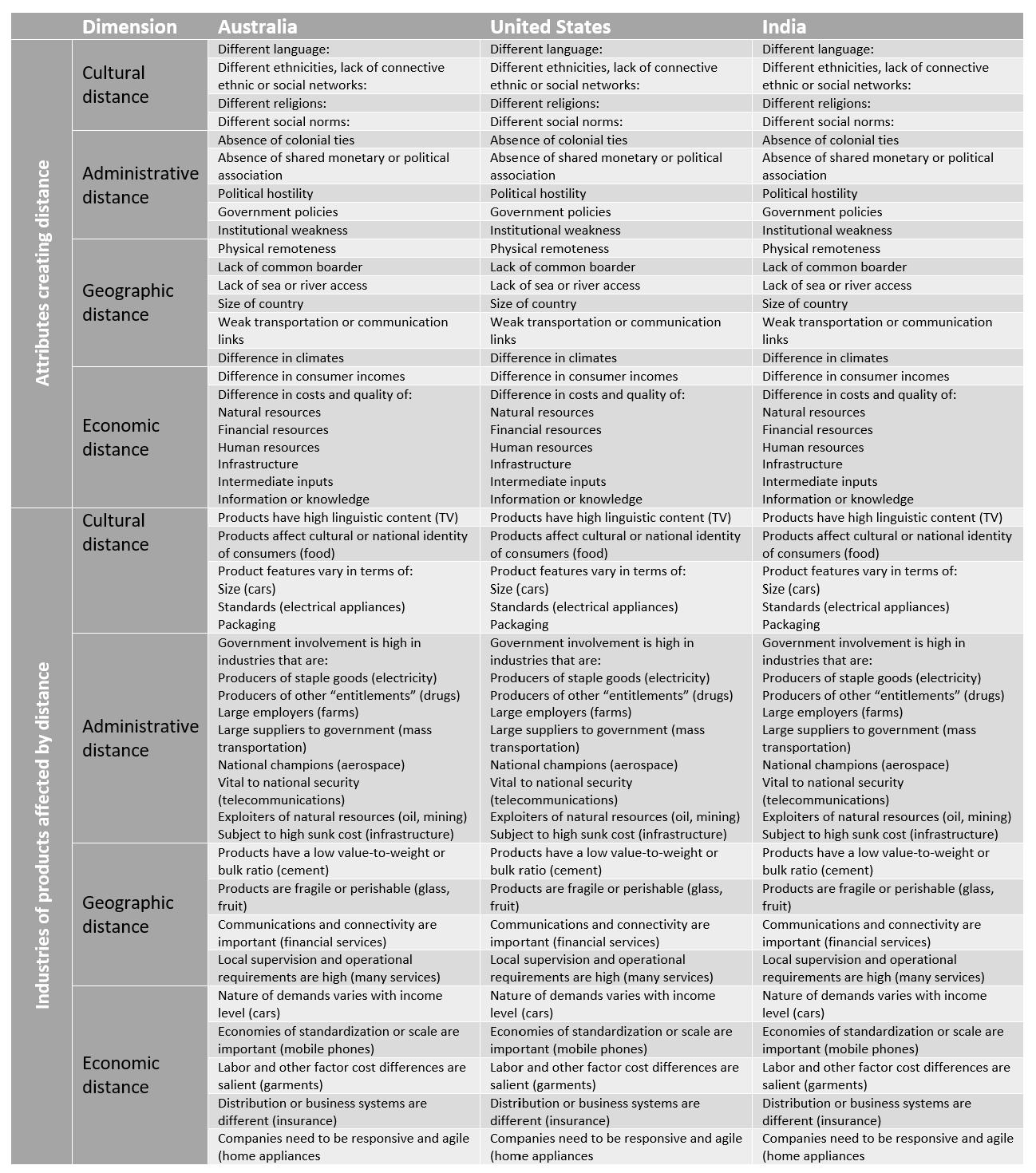Answered step by step
Verified Expert Solution
Question
1 Approved Answer
Apply the Ghemawats (2001) CAGE framework to analyse the cultural, administrative, geographic and economic differences between your firms home country (Australia) and the two foreign
Apply the Ghemawat’s (2001) CAGE framework to analyse the cultural, administrative, geographic and economic differences between your firm’s home country (Australia) and the two foreign countries (United States of America and India) you're going to screen. Thus, use the template below and replace the small black text under the three countries (Australia, United States of America and India with your answers.

Attributes creating distance Industries of products affected by distance Dimension Australia Cultural distance Administrative association distance Geographic distance Economic distance Cultural distance Administrative distance Geographic distance Different language: Different ethnicities, lack of connective ethnic or social networks: Different religions: Different social norms: Absence of colonial ties Absence of shared monetary or political Economic distance Political hostility Government policies Institutional weakness Physical remoteness Lack of common boarder Lack of sea or river access Size of country Weak transportation or communication links Difference in climates Difference in consumer incomes Difference in costs and quality of: Natural resources Financial resources Human resources Infrastructure Intermediate inputs Information or knowledge Products have high linguistic content (TV) Products affect cultural or national identity of consumers (food) Product features vary in terms of: Size (cars) Standards (electrical appliances) Packaging Government involvement is high in industries that are: Producers of staple goods (electricity) Producers of other "entitlements" (drugs) Large employers (farms) Large suppliers to government (mass transportation) National champions (aerospace) Vital to national security (telecommunications) Exploiters of natural resources (oil, mining) Subject to high sunk cost (infrastructure) Products have a low value-to-weight or bulk ratio (cement) Products are fragile or perishable (glass, fruit) Communications and connectivity are important (financial services) Local supervision and operational requirements are high (many services) Nature of demands varies with income level (cars) Economies of standardization or scale are important (mobile phones) Labor and other factor cost differences are salient (garments) Distribution or business systems are different (insurance) Companies need to be responsive and agile (home appliances United States Different language: Different ethnicities, lack of connective ethnic or social networks: Different religions: Different social norms: Absence of colonial ties Absence of shared monetary or political association Political hostility Government policies Institutional weakness Physical remoteness Lack of common boarder Lack of sea or river access Size of country Weak transportation or communication links Difference in climates Difference in consumer incomes Difference in costs and quality of: Natural resources Financial resources Human resources Infrastructure Intermediate inputs Information or knowledge Products have high linguistic content (TV) Products affect cultural or national identity of consumers (food) Product features vary in terms of: Size (cars) Standards (electrical appliances) Packaging Government involvement is high in industries that are: Producers of staple goods (electricity) Producers of other "entitlements" (drugs) Large employers (farms) Large suppliers to government (mass transportation) National champions (aerospace) Vital to national security (telecommunications) Exploiters of natural resources (oil, mining) Subject to high sunk cost (infrastructure) Products have a low value-to-weight or bulk ratio (cement) Products are fragile or perishable (glass, fruit) Communications and connectivity are important (financial services) Local supervision and operational requirements are high (many services) Nature of demands varies with income level (cars) Economies of standardization or scale are important (mobile phones) Labor and other factor cost differences are salient (garments) Distribution or business systems are different (insurance) Companies need to be responsive and agile (home appliances India Different language: Different ethnicities, lack of connective ethnic or social networks: Different religions: Different social norms: Absence of colonial ties Absence of shared monetary or political association Political hostility Government policies Institutional weakness Physical remoteness Lack of common boarder Lack of sea or river access Size of country Weak transportation or communication links Difference in climates Difference in consumer incomes Difference in costs and quality of: Natural resources Financial resources Human resources Infrastructure Intermediate inputs Information or knowledge Products have high linguistic content (TV) Products affect cultural or national identity of consumers (food) Product features vary in terms of: Size (cars) Standards (electrical appliances) Packaging Government involvement is high in industries that are: Producers of staple goods (electricity) Producers of other "entitlements" (drugs) Large employers (farms) Large suppliers to government (mass transportation) National champions (aerospace) Vital to national security (telecommunications) Exploiters of natural resources (oil, mining) Subject to high sunk cost (infrastructure) Products have a low value-to-weight or bulk ratio (cement) Products are fragile or perishable (glass, fruit) Communications and connectivity are important (financial services) Local supervision and operational requirements are high (many services) Nature of demands varies with income level (cars) Economies of standardization or scale are important (mobile phones) Labor and other factor cost differences are salient (garments) Distribution or business systems are different (insurance) Companies need to be responsive and agile (home appliances
Step by Step Solution
There are 3 Steps involved in it
Step: 1
Certainly lets apply Ghemawats CAGE framework to analyze the cultural administrative geographic and economic differences between Australia the United ...
Get Instant Access to Expert-Tailored Solutions
See step-by-step solutions with expert insights and AI powered tools for academic success
Step: 2

Step: 3

Ace Your Homework with AI
Get the answers you need in no time with our AI-driven, step-by-step assistance
Get Started


